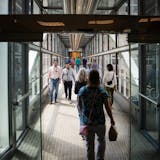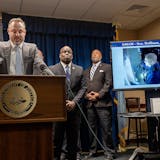The Drive's e-mail box frequently fills with reader questions about driving laws and techniques. Mary, from Bemidji, Minn., asked about the correct way to make a left turn from a two-lane road onto a four-lane road when intersections are separated by a median several feet wide.
"It's not clear to me, when I am on the minor road turning left onto the highway, and another driver coming from the opposite direction is also turning left, do we make our turns in front of each other?" she wrote in an e-mail. "Or, because of the distance ... do we drive just past each other, then make our left-hand turns? Is there a defining distance that determines the type of turn in this situation?"
The Drive posed her questions to Ray Kroll, Region 5 director of the Minnesota Driver and Traffic Safety Education Association and a driver's education instructor at De La Salle High School in Minneapolis.
When motorists coming from opposite directions are making left turns onto a road or highway split by a median of sufficient width, like a grassy median several feet wide, motorists should pass each other before making their left turns, Kroll said.
"My experience is that it should be wider than the length of a normal size vehicle," Kroll said, pointing to intersections along NE. Stinson Boulevard between St. Anthony Boulevard and NE. 18th Avenue in Minneapolis.
The answer for motorists coming from opposite directions making left turns at regular city intersections is illustrated on page 24 of the Minnesota Driver's Manual.
In this situation, "drivers never drive in front of each other, rather they turn left without crossing each others path," Kroll said. "In other words they remain on the right side of each other."
That would be the case for eastbound and westbound traffic turning from University Avenue in St. Paul onto northbound or southbound Snelling Avenue. Signalized turn arrows are used to direct left turns at that intersection.

![A black bear stopped after crossing Big Bay Road on Madeline Island, the largest of the Apostle Islands in Wisconsin, on Monday, May 31, 2021. ]](https://arc.stimg.co/startribunemedia/PWNYGIY3WTSWDBOGOYD775DPP4.jpg?&w=80&ar=1:1&fit=crop)

